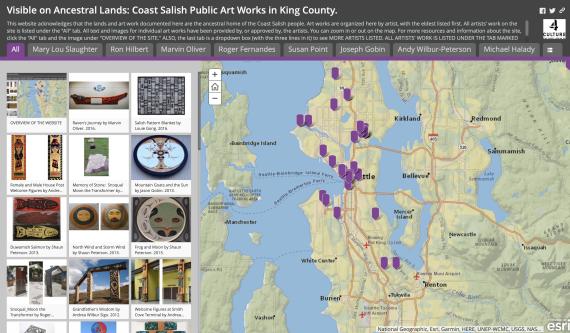A new resource, a website called, “Visible on Ancestral Lands: Coast Salish Public Art Works in King County,” documents the public art created by Coast Salish artists and installed in King County. That is, the art that is permanently installed in public locations for all to see. The website was created by Crisca Bierwert, an Affiliate Associate Professor in the Department of Anthropology at the University of Washington.
This is a collaborative project. Crisca created the website by working with the Coast Salish artists who have public art in King County. The commentaries on each art work were either written or approved by each individual artist. Photographs were provided by the artists, by commercial photographers, or by the public agencies that funded the art. Crisca also acknowledges many local indigenous leaders for contributing ideas to the website, and she acknowledges staff from local arts agencies for contributing information as well.
Crisca sees the website not only as a resource in itself, but something that will encourage people to see the artwork, rather than learn simply from the internet or from books. On the website, under a tab labelled “All,” all the art works are listed, from the most recent to the oldest. Seeing them together, a person can see that the themes and styles of Coast Salish art vary a great deal. The artists’ commentaries also vary in how much they share and in what they share.
There are actually three websites, one that groups the art work by theme (e.g. Welcome Figures, Orcas, etc.):
https://uw.maps.arcgis.com/apps/Shortlist/index.html?appid=1f0f86362ce24c8d95e970a714832c84
A second version groups the artwork by artist, with the eldest artist first:
https://uw.maps.arcgis.com/apps/Shortlist/index.html?appid=5784a2f94b324ba78cc939d3f96d1726
The third site provides background information on Coast Salish history, Recent Coast Salish Art History, lists of artists, and so forth, along with more information about the website:
https://coastsalishpublicart.wordpress.com/
All three of these sites have links to one another.
In a section “About the website,” Crisca writes, “The title of the website, ‘Visible on Ancestral Lands,’ reminds us that King County is Coast Salish territory. This land has supported the lives and cultures of Native American people who were the first people to live on this land. Coast Salish people still live here, on the lands of their ancestors; and the Coast Salish cultures are very much alive. So, by mapping Coast Salish artwork, this website mean to emphasize these enduring connections. And by exploring the map, reading the artists’ messages, and visiting the art work, you can also better understand and share those connections, whether you are a Coast Salish person or from another heritage.”
These are non-commercial sites, intended for educational purposes. Crisca Bierwert created the website using an ArcGIS Story Map template available to her through her UW affiliation. King County 4Culture provided a Heritage grant for modest honoraria for artists, and for photography primarily. As noted above, the commentary on art work and biographies were provided by or approved by each artist. The background information sections on this WordPress website — about the website, Coast Salish history, Recent Coast Salish art history, etc. — were written by Crisca Bierwert. The website presenting art works by Themes includes paragraphs also written by Crisca, and she grouped the art works.
Crisca began studying Coast Salish art in 1976, when a graduate student in anthropology at the University of Washington. The following year, she began the study of the Lushootseed language. She worked with two very gifted and generous teachers: Bill Holm about the art, and Vi taqʷšəblu Hilbert on the Lushootseed language. She continued her work on Lushootseed during 25 years away, at the University of Michigan. On returning to Seattle, she resumed studying contemporary Coast Salish artworks, and she became a Board Member of Lushootseed Research, a non-profit organization founded by Vi taqʷšəblu Hilbert and now led by her granddaughter Jill LaPointe. Crisca considers herself a scholar-activist and ally, what Gail Morris has called “an accomplice” in the work of cultural advocacy. Her publications focus on Coast Salish people and culture.
The website is a work in progress. Crisca writes, “I have been working with educators in the Native Education department of the Seattle Public Schools with the goal of getting resource to teachers and students, and to develop the curriculum aids needed. My hope and expectation is to expand the site throughout Coast Salish country, albeit gradually, and to be able to have a customized website design built, one with an even better format for viewing the art online. I think that with sufficient use to demonstrate the value of the site, I will be able to expand it and improve it, and ultimately turn it over to another (non-profit organization) for annual updating. Maybe the idea will even catch on and be taken up in other localities.”
To provide feedback, including comments or suggested additions, send an email to Crisca at coastsalishpublicart@gmail.com
